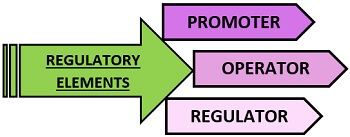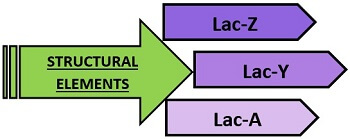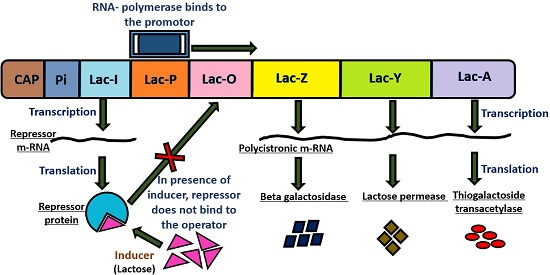Lac-operon is a system that involves the regulation of protein synthesis or the synthesis of enzymes by a set of genes. This concept can be well studied by the gene expression in prokaryotes like E.coli and other bacteria. The concept of Lac-operon was first explained by Jacob and Monad in E.coli.
Lac-operon refers to the system that can regulate the metabolism or utilization of lactose (as the sole carbon source). In E.coli, a lac-operon contains a gene sequence that controls the gene expression by switching on and switching off the system.
Lac repressor and catabolite activator protein (CAT) are the two gene proteins in which the former functions as a lactose sensor and the latter acts as a glucose sensor. Therefore, the lac-repressor and CAT are the two main components of the Lac-operon.
Lac repressor generally blocks the gene transcription but expresses itself in the presence of inducer molecules, i.e. lactose. CAT activates the gene transcription only at low glucose levels through the hunger-sensing molecule, i.e. cAMP (cyclic adenosine monophosphate). In this context, we will briefly study the concept, structure, components and regulation of the Lac-operon system.
Content: Lac-Operon
Operon
It is a system of DNA containing a sequence of genetic codes or carries a sequence of genes that code the m-RNA and direct the synthesis of enzymes for protein synthesis. An operon is a coordinated system in which all the genes coordinate to mediate the regulation of gene expression.
Components of Lac-Operon
An operon primarily consists of two elements or genes:

Regulatory Elements
It includes the following regions:

- Promotor Region: It codes the Lac-P gene. It lies between the regulator and the operator. RNA-polymerase binds to this site as a promoter region initiates transcription. It is 100 base pairs long. It consists of palindromic sequences. This site promotes and controls the transcription of structural genes or m-RNA. The regulatory genes of the repressor regulate the functioning of the promoter region.
- Operator Region: It codes the Lac-O gene. It lies between a promoter and the structural gene (Lac-Z). It contains an operator switch, which decides whether transcription should take place or not. The regulatory gene binds to the operator.
- Regulator Region: It codes for the regulator gene (Lac-I) that controls the activity of the promotor and an operator gene. This regulatory gene produces regulatory proteins known as “Repressor proteins” that can bind to the promoter and operator.
Structural Elements
These are the regions of DNA, which contain genes for protein synthesis, and they are of three kinds:

- Lac-Z: Encodes for the enzyme beta-galactosidase.
Function: Beta-galactosidase brings about the hydrolysis of lactose into galactose and glucose subunits. - Lac-Y: Encodes for the enzyme lactose permease.
Function: Lactose permease brings lactose into the cell. - Lac-A: Encodes for the enzyme thiogalactoside transacetylase.
Function: Thiogalactoside transacetylase function is not very clear, but it assists the activity of the enzyme beta-galactosidase.
These three, i.e. Lac Z, Y and A genes, are present adjacent to each other. Therefore, all the elements like promotor, operator, repressor and structural genes together form a unit called Operon.
Video: Lac Operon
Control of Gene Expression in Prokaryotes
In prokaryotes, the Lac-operon system is controlled in two ways:
- Positive control
- Negative control
Positive Control of Lac-Operon
It is also called a Positive inducible system and includes the following steps:
- Firstly, a regulatory gene expresses the repressor protein.
- After that, repressor proteins are produced by the expression of a regulatory gene.
- A repressor protein has binding sites for the operator and the inducer (lactose).
- When lactose is present as an inducer, it binds with the repressor protein and forms the R+I complex.
- After the binding of the inducer to the repressor, the complex blocks the binding of the repressor to the operator.
- As the repressor protein does not block the operator, the RNA polymerase binds to the promotor and moves further to transcribed mRNA.
This concept is known as the switch on of Lac-operon (by the presence of an inducer).

Negative Control of Lac-Operon
It is also called Negative control of the repressor system. It includes the following steps:
- First, the regulatory gene is expressed by the repressor.
- A repressor protein is produced after the expression of a regulatory gene.
- In the absence of an inducer or lactose, the repressor protein directly binds to an operator.
- This blocks the movement of RNA polymerase and its attachment to the promoter.
- At last, mRNA transcription will not occur.
This concept is known as the switch off of Lac-operon (by the absence of an inducer).

Inducer
It is also termed an Antirepressor. It suppresses the activity and binding of the repressor protein to the operator and makes it an inactive repressor from the active repressor. A lactose or allolactose functions as an inducer in Lac-operon. Allolactose forms by the enzyme beta-galactosidase as a result of the isomerization of lactose, i.e. galactose links to the C6 instead of C4. It is a kind of complementary substance that participates in switching on and off the operon system.